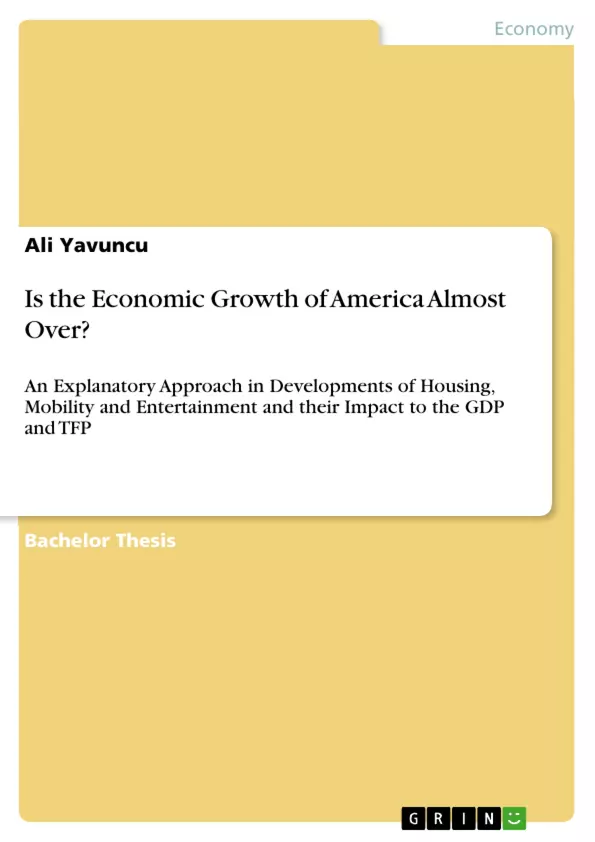This paper first introduces different inventions with their historical background in the period from 1870 to 1940, comparing the necessity of the different topics in different periods from 1940 till now.
Afterwards, this papers conducts the analyses, explaining the growth in Total Factor Productivity (TFP) and Gross Domestic Product (GDP). Last but not the least, the economic and social benefits of different inventions are explained widely.
At its end, this paper shows that some inventions like autonomous cars or a futuristic transportation system can give the economy a boost or increase life expectancy. With the smart house, in which life is more convenient, the difference between the past and the future would become visible.
Human existence changed dramatically after the Civil War in the United States. However, thanks to a number of ‘Great Inventions’ in particular, electricity and the internal combustion engine life began to improve exponentially.
Housing became more comfortable when tied to systems of heat and sewage. Life changed dramatically after innovations that affected housing for instance, indoor plumbing, running water, and sewers. Other life-changing innovations like automobiles, electricity, the airplane, the telephone and many others also helped increase the standards of living in America, but such a phenomenon could have occurred only once.
Inventions lead to incredible growth, but this cannot be continuous. When consumption is fully exhausted, only new inventions can lead to new growth trajectories. Once an invention has been made, it does not mean that it leads to automatic growth.
Invention must be adjusted over a time, and this process leads to steady growth over a decade or a long period of time.
During the period from 1870 to 1940, the change in growth rates was incredible. Till 1870, houses were isolated, but by 1940, they were connected to five important systems, viz., water, gas, telephone, electricity, and possibly the most important one—sewage. While analysing different types of inventions, it must be said that Gordon (2016) could be right with his predictions that growth is almost over.
Inhaltsverzeichnis (Table of Contents)
- Introduction
- Main Part: Importance of the Great Inventions from 1870 to 1940
- Housing: From Dark and Secluded to Bright and Networked
- Mobility: Transportation and its Improvements
- Entertainment: Information, Communication, and Entertainment
- Importance of the Great Inventions from 1940 to 2015
- Transformation of Housing
- Mobility: Attempts to Copy the German Autobahn
- Entertainment: Improvements through the Mainframe and PC
- Comparison: Why are Inventions Important
- Why was Electricity Important
- Why was Water Flow Important?
- Transportation: Railroads to Automobiles
- Role of Air Travel
- Role of Mainframes and Early Networks
- Analysis
- Rise and Fall of Total Factor Productivity (TFP)
- Rise and Fall of Gross Domestic Product (GDP)
- Correlation between Electricity and GDP
- Role of Motor Vehicles in the Economy
- Social and Economic Benefits of Airplanes
- Decline in Improvements in Entertainment
- Importance of Future Inventions
- Autonomous Driving
- Economic Benefits of Autonomous Vehicles
- Hyperloop Transportation
- Economic and Productivity Benefits of the Hyperloop
- The Smart Home
- Autonomous Driving
- Conclusion
Zielsetzung und Themenschwerpunkte (Objectives and Key Themes)
This thesis examines the impact of major inventions on the economic growth of the United States, particularly in the areas of housing, mobility, and entertainment. The author explores the historical context of these inventions, analyzes their contributions to Total Factor Productivity (TFP) and Gross Domestic Product (GDP), and considers the potential for future innovations to stimulate economic growth.
- The significance of "Great Inventions" in driving economic growth in the United States.
- The evolution of housing, mobility, and entertainment technologies and their respective impacts on TFP and GDP.
- The historical context and economic benefits of key innovations like electricity, automobiles, airplanes, and computers.
- A comparative analysis of the importance of inventions across different periods.
- An exploration of future technologies such as autonomous vehicles, hyperloop transportation, and smart homes, and their potential for economic growth.
Zusammenfassung der Kapitel (Chapter Summaries)
The introduction sets the stage for the thesis by highlighting the transformative impact of key inventions, particularly electricity and the internal combustion engine, on American society and economic development. It argues that while inventions can lead to exponential growth, such growth may not be continuous. The paper delves into the historical background of various inventions, focusing on their development and impact in the period from 1870 to 1940. These inventions, ranging from housing improvements to advancements in mobility and entertainment, are analyzed in detail, outlining their significance and contributions to the evolution of American society. The paper further explores the importance of these inventions in the period from 1940 to 2015, examining the continuation and further development of these technological advancements.
The analysis section explores the relationship between inventions and economic growth. It investigates the rise and fall of Total Factor Productivity (TFP) and Gross Domestic Product (GDP), analyzing the correlation between specific inventions, such as electricity and motor vehicles, and these key economic indicators. The paper discusses the social and economic benefits of various inventions, highlighting their impact on living standards and societal progress. Finally, the paper examines the potential of future inventions, such as autonomous vehicles, hyperloop transportation, and smart homes, to contribute to economic growth and improve quality of life.
Schlüsselwörter (Keywords)
This thesis focuses on the relationship between economic growth, innovation, and technological advancements in the United States. Key concepts include Total Factor Productivity (TFP), Gross Domestic Product (GDP), housing, mobility, entertainment, electricity, automobiles, airplanes, computers, autonomous vehicles, hyperloop transportation, and smart homes. The author explores the historical context of these inventions and their impact on economic development.
- Quote paper
- Ali Yavuncu (Author), 2017, Is the Economic Growth of America Almost Over?, Munich, GRIN Verlag, https://www.grin.com/document/1193190



